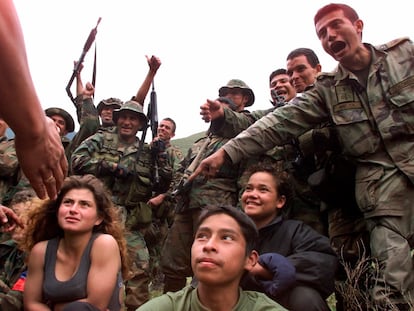The battle against forced recruitment in Colombia
Social organizations in the Cauca Valley region are trying to stop a crime against children that — according to the Association of Indigenous Councils — occurred more than 150 times in 2023


After walking for hours in complete darkness in the middle of a minefield, David (not his real name) would find his way to freedom. This was the only way to escape from the armed group that he had been forced to join. With the greatest of stealth, he achieved this feat. Then, he raised his arms in the air: this was the signal that would warn the Colombian military that he was the young man that the Ombudsman’s Office had warned about hours before — the sign that would save him from being shot.
The message had reached the Ombudsman’s Office thanks to Ana (not her real name), an Indigenous leader. David’s family had contacted her to beg for help. Their son had managed to warn them that he planned to escape. Ana’s participation was key: she knew exactly who to turn to. She has been helping the families of children who have been forcibly recruited in the Cauca Valley region of Colombia for nearly half-a-decade.
David’s story has become part of the landscape in the north of the region, one of the most disputed areas in Colombia. According to the Association of Indigenous Councils of Northern Cauca (ACIN) — the main Indigenous organization in the region — over the last two years, more than 300 minors have been forcibly enlisted into armed groups. The organization’s human rights team explains that recruitment was radically transformed after the Peace Agreement was signed between the government and the FARC in 2016. As the conflict worsens again, this tragedy is on the rise. Ana has counted 117 complaints so far in 2023… and she assures EL PAÍS that the amount of underreporting is huge.
The Ombudsman’s Office has highlighted the risk. According to the entity, since 2021, officials have reported 344 cases of minors being recruited in the country. At least 48% of these are from 2023. The majority of complaints come from the Cauca Valley, followed by the regions of Nariño, Arauca and Putumayo. “A very worrying situation persists: the occurrence of recruitment [largely takes place among the] Indigenous population, where 75% of the cases are concentrated,” explains Carlos Camargo Assis, the ombudsman of Colombia, in a public statement.
Behind these figures, there are other characteristics that worsen the already tragic situation. Andrea (not her real name) — who belongs to one of the civil society organizations active in the Cauca Valley — maintains that, after the departure of the Western Joint Command of the now-extinct FARC, little by little, new and numerous illegal armed groups were born. Over the years, they have grown. From about 60 members, there are now over 1,000 insurgents in the region, according to Andrea.
The Jaime Martínez column — part of the umbrella of FARC dissidents known as the Central General Staff — is the armed structure that holds the most power in the northern part of the Cauca Valley. It’s the entity that has most often been accused of forcibly recruiting minors into its ranks. The United Nations reiterated this warning in 2022, when Colombia reappeared in its annual report on Children and Armed Conflict.
The second-largest recruiter of children in Colombia is the National Liberation Army (ELN), which maintains a long-standing dispute with the Jaime Martínez column. Then, there are the groups that are part of the other large federation of dissidents: the Second Marquetalia, which is led by former FARC leader Iván Márquez. They intervened in this regional dispute, without much success.
Andrea explains that, when recruitment restarted in the north of the Cauca Valley — a subregion officially made up of 13 municipalities — the minors enlisted tended to be sons, nephews, or cousins of Indigenous authorities, or older adolescents who belonged to the Indigenous Guard. The armed groups valued boys who were in good physical condition, had some political training and were part of the region’s social fabric. Between 2018 and 2019, the age range of those recruited was between 14 and 17-years-old.
The dynamics have since worsened. In 2020, the ACIN began to register complaints about the recruitment of children as young as 11-years-old. And now, it’s more common for the victims to be minors in conditions of extreme poverty, or minors who have faced domestic abuse. They are promised food, clothing, or some financial compensation. Likewise, massive recruitment raids — in which armed men kidnap groups of boys and girls outside of schools — became more common post-2020. The most notorious cases occurred in March of this year. One happened in an educational institution in the town of Caloto. Another took place the same week, on San Pedro Street in the same municipality, while some children were heading to a local school.
Faced with these risks, the Indigenous communities of the area have reacted with internal measures to control and monitor the children. In this way, they have managed to recover two abducted minors. They have established alert systems: if the presence of unknown or armed men near a school is detected, the Indigenous Guard is quickly onsite to protect the children. An effective protocol, but one that has turned them into staunch enemies of illegal armed groups.
Ana’s cell phone is always on. She knows that, oftentimes, someone’s life depends on her answering a call. Not only do Indigenous families come to her, but so do the young people themselves. She remembers a call in which she was notified about a group of young people who were on their way to meet a recruiter. She activated the protocol, mobilized the Indigenous Guard and managed to stop the vehicle that the insurgent was travelling in. The informant turned out to be one of the boys, who refused to let his friends end up in the war.
That was an exceptional outcome. Andrea explains that armed groups have been creating illegal recruitment mafias — they sometimes delegate the recruitment of their peers to young people. On other occasions, they hire third parties who are in charge of identifying the children or adolescents, following them, convincing them, abducting them and taking them to the camps. These third parties are paid according to the number of children recruited.
The sophistication of human-trafficking for the purpose of armed conflict has resulted in a local issue becoming more widespread. NGOs in the area found that children enrolled in the northern part of the Cauca Valley end up being transferred to the south of Cauca, or to nearby cities, such as Tumaco and Buenaventura, where violence is prevalent.

Fighting against the current
“As long as the children need me, I don’t rest,” Ana explains. She doesn’t have much peace of mind left: because of all the cases she’s handled, she has become the number one reference in the region. In the remote villages — where she goes to take reports from the families of missing children — she has been profiled by insurgents. She has learned to move through a dangerous environment.
Ana has no bodyguards, nor does she receive remuneration for this work. Hence, she’s always had to have a day job to pay her bills, while forging alliances to fight against forced recruitment and stay safe. Things haven’t been easy. The obstacles she encounters on a daily basis continue to multiply. She must deal with negligent officials, with a precarious relationship between local and national institutions, along with the high economic cost of removing entire families from one place to another for their security.
Her tasks are varied and painful. The majority of minors who escape or are handed over by the militants (the Ombudsman’s Office or the International Red Cross sometimes intervene in a handover) return to the Indigenous community with physical health problems, such as injuries from explosives, or mental problems, due to having suffered from sexual violence.
When they turn up dead, it’s even more difficult. According to Andrea and Ana, this is increasingly common. “They give them a weapon and they send them off to fight,” Andrea laments. Just a few months ago, 40 bodies appeared in the town of Silvia, in rural Cauca. Some of them were recruited minors. The families discreetly claimed the bodies for fear of reprisals. And, at night, with no witnesses, they buried them.
The effect of this violence on Indigenous peoples is profound and irreparable. “They’re uprooting our seed,” Andrea reflects. Edwin Capaz — the former Senior Councilor of the Regional Indigenous Council of Cauca — agrees with this. “The war is shearing us, it’s cutting off the significance of Indigenous peoples. [The violence has] festered in these generations of children, adolescents and young people, who are our most vulnerable side,” he emphasizes. Both Andrea and Edwin agree that the Colombian state’s measures are not enough to address a phenomenon that is growing at an unstoppable rate.
Despite the social and human impact, the issue hasn’t been discussed in the dialogue that the government has established with the ELN or the Central General Staff. So far, forced recruitment hasn’t managed to achieve the public attention that the kidnapping epidemic has gained. “[Forced recruitment] needs to be an urgent point, because of what it means not only for Indigenous peoples, but for the population in general,” Councilor Capaz emphasizes. While this happens, Ana, her community and the organizations she works with aren’t thinking of giving up. They continue to act with everything they can muster.
Ana is driven by the strength that she finds in her own history of fighting violence. After her interview with EL PAÍS, she’ll be getting ready to go out and hear another complaint from a family.
A young woman — who, a few weeks ago, arrived to accompany her voluntarily — silently witnesses the interview, takes notes and listens attentively.
“How do you do so much, Doña Ana? I don’t understand.”
“Because it’s all done with love. It’s in our hands to save lives.”
Sign up for our weekly newsletter to get more English-language news coverage from EL PAÍS USA Edition
Tu suscripción se está usando en otro dispositivo
¿Quieres añadir otro usuario a tu suscripción?
Si continúas leyendo en este dispositivo, no se podrá leer en el otro.
FlechaTu suscripción se está usando en otro dispositivo y solo puedes acceder a EL PAÍS desde un dispositivo a la vez.
Si quieres compartir tu cuenta, cambia tu suscripción a la modalidad Premium, así podrás añadir otro usuario. Cada uno accederá con su propia cuenta de email, lo que os permitirá personalizar vuestra experiencia en EL PAÍS.
¿Tienes una suscripción de empresa? Accede aquí para contratar más cuentas.
En el caso de no saber quién está usando tu cuenta, te recomendamos cambiar tu contraseña aquí.
Si decides continuar compartiendo tu cuenta, este mensaje se mostrará en tu dispositivo y en el de la otra persona que está usando tu cuenta de forma indefinida, afectando a tu experiencia de lectura. Puedes consultar aquí los términos y condiciones de la suscripción digital.
More information
Archived In
Últimas noticias
Sydney Sweeney, the actress praised by Trump: ‘Women are up against what society wants them to be’
The Bolsonaro surname: An advantage or liability in Brazil’s 2026 presidential elections?
Raúl Rocha, from jet-setting with Miss Universe to arms trafficking and fuel theft
80,000 barrels of Mexican oil sent to Cuba: Havana drawn into the US–Mexico clash
Most viewed
- Reinhard Genzel, Nobel laureate in physics: ‘One-minute videos will never give you the truth’
- Pablo Escobar’s hippos: A serious environmental problem, 40 years on
- Charles Dubouloz, mountaineering star, retires at 36 with a farewell tour inspired by Walter Bonatti
- Why we lost the habit of sleeping in two segments and how that changed our sense of time
- The fall of a prolific science journal exposes the billion-dollar profits of scientific publishing










































